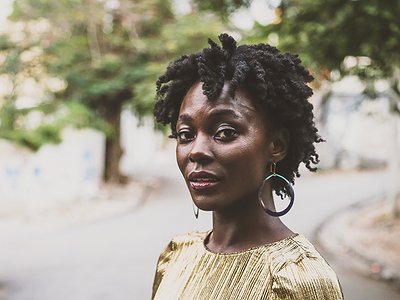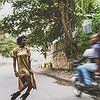Part 1
Name: Nathalie Joachim
Nationality: American
Occupation: Performer / Composer
Current release: Fanm d’Ayiti on New Amsterdam
Recommendations: The Warmth of Other Suns by Isabel Wilkerson / Sangoma by Miriam Makeba
Website/Contact: Visit Nathalie's website at www.nathaliejoachim.com
When did you start playing your instrument, and what or who were your early passions and influences? What is about music and/or sound that drew you to it?
I started playing flute when I was 9 years old. Before that, I played piano (quite poorly) beginning at age 4, and spent a lot of time singing, both in choir and with my grandmother. She was one of my greatest early musical influences, as was Bjork...both quite different, LOL. I have always been quite obsessed with music for as long as I can remember. My favorite thing to do was to hang out in Tower Records for hours on end (between my music classes at Juilliard) listening to all of the albums at the listening stations. So, I’d say I grew up with a fairly broad musical palette while studying classical music.
For most artists, originality is first preceded by a phase of learning and, often, emulating others. What was this like for you? How would you describe your own development as an artist and the transition towards your own voice? What is the relationship between copying, learning and your own creativity?
Much of my early music education was about emulation. So much so that I found my time with my grandmother (who is featured on this album) to be quite liberating. Unlike my classical music training, she really invited me to use my own voice to tell a story, and to be proud of it. I think that it wasn’t until about 2015 - the year of her passing - that I started to embrace that more fully in my artistic practice. And now I feel like I am for the first time, making work that is truly representative of all that I am - a black woman, a Haitian American, and a creative artist. Fanm d’Ayiti is a product of that.
What were some of your main artistic challenges when starting out as an artist and in which way have they changed over the years?
For a very long time I didn’t feel comfortable calling myself a composer, because the people for whom that title was reserved did not look, or live, or create music that was anything like mine. I simply did not feel that that title belonged to me, even though I was actively writing, practicing, and studying music pretty constantly. I eventually hit a point where claiming all of my artistry and standing in the truth of it became central to my existence on and off stage. I now think very little about how I will be perceived, or what others may feel I deserve, and am much more focused on whether or not the work I’m investing time in is serving my purpose as an artist and as a person. That change in mind-set has led to a handful of years of my very best work to date, and a pretty constant hunger to continue creating.
Tell us about your studio/work space, please. What were criteria when setting it up and how does this environment influence the creative process? How important, relatively speaking, are factors like mood, ergonomics, haptics and technology for you?
I am on the road a lot, so although I can be rather hermit like and am very much attached to my home studio space, I have learned to create work-conducive spaces just about anywhere. At home, my studio definitely has a vibe to it - candles, crystals, palo santo, sprigs of dried eucalyptus and lavender, and a small number of essential books for inspiration and reference. All organized sparingly, with no clutter, and my computer, synthesizers, instruments and a few essential audio playback options at the center of the space, with lots of natural light. When I travel, I try to recreate a similarly clutterless, light-filled, energy-cleared space. I scope out the living space or classroom that I will call home, and rearrange the work area to receive the most natural light, then set up my gear, crystals, candles and instruments that I always travel with. Basically...I’m a hippie on wheels, LOL, but it gets the job done! Much of Fanm d’Ayiti was made under the sun and near water, and I found that that really helped my clarity of mind.
Tell me about your instrument, please. What was your first instrument like and how did you progress to your current one? How would you describe the relationship with it? What are its most important qualities and how do they influence the musical results, including your own performance?
I am generally working with three flutes. My primary instrument is a hand-crafted rose gold beauty made by Lillian Burkart. Lillian also made my piccolo and both are simply a dream to play. I usually am also traveling with my alto flute, which is moody but delicious. These are all much nicer than whatever terrible student instrument I started on at nine years old, but I’m really not a gear head. Lots of people buy new flutes and accessories constantly. I’ve had all of these instruments for well over a decade, and we continue to grow together. I feel that way about my voice as well, which has been with me since day one. My relationship to each of these instruments is as much about me continuing to get to know them as it is them adapting to my ability. It’s ever-evolving...I wouldn’t trade them in for anything.
Could you take us through a day in your life, from a possible morning routine through to your work? Do you have a fixed schedule? How do music and other aspects of your life feed back into each other - do you separate them or instead try to make them blend seamlessly?
I wouldn’t say that any two days of my life look the same, but I do always start with a routine: Every morning, I wake up at about 6 or 6:30am, and the first thing that I do is do yoga and meditate, even if only for 30 minutes. I took up this regimen a handful of years ago when I threw out my back playing alto flute (...I know...nerd alert...), and find that it centers my body and my mind for the day. It’s become a pretty essential part of my day. After a quick shower and some breakfast, I’m off to the races. If I can, I pack the earlier part of my day with administrative work - emails, meetings, etc. That’s my best brain time for that type of work. Late mornings and afternoons are for music playing - rehearsals, practicing, etc. My best music writing happens in the evenings, so when I’m not performing, I have a pretty dedicated writing time from about 7-11pm. As I said, every day is different, but on Sundays, I lay out a schedule for myself for the week, leaving time to eat (one of my great joys, LOL), and always some time for play with friends and family. I check in with my schedule every evening before bed, so I head into the next day with some clear goals. I think it’s fair to say that I function best with a schedule, and that music is at the core of just about everything that I do.
Could you describe your creative process on the basis of a piece or album that's particularly dear to you, please? Where did the ideas come from, how were they transformed in your mind, what did you start with and how do you refine these beginnings into the finished work of art?
Creating Fanm d’Ayiti was wonderful in that it shifted my practice into a much more flexible process. This project involved about two years of research: going to Haiti and Miami to meet the artists featured on my project; spending time with family and in ancestral spaces for inspiration; and some very deep listening and conversation. The initial idea for the project came after the passing of my maternal grandmother, and was further ignited when I was approached by Kate Nordstrum (curator of the Liquid Music Series), who commissioned the work. I wasn’t sure that I would find anything monumentally interesting, and I also wasn’t sure what form the project should take, so I spent most of my two years of building work, allowing the material to tell me how it wanted to be presented. Because of that, I feel that the finished product has an authentic sense of place and self. It was the first time that I really removed my own preconceived notions of my desired outcome for a work, and just trusted the process instead of forcing the material into a predefined form...and that was absolutely terrifying! However, it resulted in some of my most clear and honest works to date, and I have carried that into all of my projects since.
There are many descriptions of the ideal state of mind for being creative. What is it like for you? What supports this ideal state of mind and what are distractions? Are there strategies to enter into this state more easily?
My ideal state of mind for being creative is one of openness and receptivity. I find that to best access that space, I need to shut out distractions of the modern world - often finding some remote space with no cell phone service to disappear to for a few days, or shutting down my devices and hermiting up in my home for some days. If I can’t do that, then I take a few moments to breath, set some clear intentions and quiet my own mind’s chatter.






